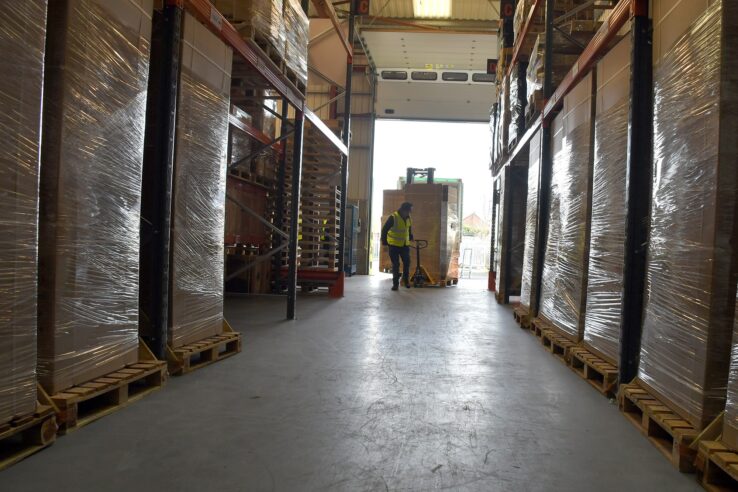We’re pleased to announce the release of OrderFlow 4.4.3. This follows hard on the heels of 4.4.2 so we’ve combined the two announcements. The releases include new courier API integrations with Intersoft and Fedex, as well as a shopping cart integration with API2Cart. Among other changes, we’ve added features that make it easier to process stock move tasks in the warehouse, and added some useful options around the receipt of stock and handling of back orders.
Courier Integration
We’ve created an integration with Intersoft’s new Sapient API. This API is earmarked to replace the Intelligent Shipper API for all Royal Mail shipments, and could also be potentially be used in the future to create labels for other supported carriers. All OrderFlow customers using Royal Mail will need to upgrade to the Sapient API over the next few months, with the exact time scale still to be determined.
In the case of Fedex, from OrderFlow 4.4.3 it will be possible to use the new REST-based API for shipment notifications and label generation. This API will ultimately replace their existing SOAP API. All customers using Fedex will need to migrate to the new API, although this will not need to happen immediately after the next 4.4.3 upgrade.
As part of the Fedex integration, we’ve introduced changes to allow for better display of error messages raised during courier validation, an improvement that will also apply for other courier integrations.
API2Cart Integration
In the latest releases we created the first version of our integration with API2Cart, a service provider with connectors to various shopping carts and e-commerce platforms. With this integration in place, OrderFlow will in the future have another option for shopping carts for which we don’t already have a native integration.
Please note that some additional development work is still likely to be necessary for each new shopping cart for which the API2Cart integration is used.
Goods Receipt
With the recent releases we’ve introduced a number of improvements in the management of incoming stock.
It is now possible to record expected product lots and units of measure against purchase order lines. Previously, it was only possible to record expected quantities at a product level.
We’ve added a new handheld delivery receipt mechanism that is optimised for item by item receipt, where received stock is placed directly into a target location selected by the user. For this flavour of delivery receipt, the goods-in quantity is set by default to one, but this can be overridden as required.
With OrderFlow 4.4.3 it is now possible to receive stock based on configured units of measure, while still using pieces for subsequent stock tracking. This option allows units of measure to facilitate simple and more accurate quantity recording, without having to accept the full overhead of managing stock subsequently on a multi-UOM basis.
This release also introduces more flexibility in the selection of the licence plate type used to receive stock. It is now possible to use a script to apply this selection automatically. This allows, for example, for products that will be put away at the pallet level (as whole licence plates) to be received in the same delivery as products that will be put away as items (without licence plates).
We’ve also added a mechanism to record delivery level operations for auditing and reporting purposes.
Stock Management
Prior to 4.4.3, OrderFlow has allowed for named units of measure (e.g. ‘cartons of 12’) as well as ‘pieces’, which are always associated with a quantity of 1 (per stock item). It is now possible to set a label for pieces, which can be useful for SKUs that represents a multi-pack item which is not divisible for stock tracking purposes.
A relatively recent OrderFlow enhancement allows for alternative picking locations to be automatically selected when short picks occur. Prior to 4.4.3, this mechanism excluded ‘ring-fenced’ order lines, where the picking locations need to use specific stock (for example, when an order line must be fulfilled using a specific product lot). With OrderFlow 4.4.3 we’ve made it easier to perform alternative picking location selection in these types of circumstances.
Stock Move Tasks
With OrderFlow 4.4.3 we’ve added various improvements applicable to customers using desktop-based stock move task processing (rather than using the handheld GUI).
Another change in this release concerns stock move tasks whose target lines are created without a target location being set. This may, for example, be a bulk stock transfer for which all of the stock needs to end up in a specific location, but that location is not known at the time of task creation. For these types of tasks, it is now possible for the operator to set the single target location for all target lines via a one-step operation. Previously, it would have been necessary to set the target location separately for each target line, before the task as a whole can be applied.
It is also now possible using the desktop GUI to complete a task on a product by product basis. Previously, it was only possible to complete all of the task lines via a single button press. The incremental task line completion allows for stock changes associated with the separately completed task lines to take effect earlier, which is particularly helpful for large tasks or tasks where there may be a delay completing some of the lines.
With OrderFlow 4.4.3, it is now possible to cancel task lines individually via the desktop GUI. Previously, it was only possible to use this interface to cancel the task as a whole.
Note that task lines associated with order picking cannot be cancelled in this way.
Back Order Merging
In the most recent releases we have introduced a feature that allows for merging of shipments containing back order lines.
The feature is particularly useful for trade customers to whom you despatch regular orders. Where a back order is waiting for incoming stock the expected delivery doesn’t have to trigger an immediate despatch. Instead, the back order can be held for configurable period or until it is manually progressed. If a new order is then received for the same customer, the feature allows for the available lines from the back order to be merged with the new one, saving on handling and shipping costs.
Channel and Organisation Management
With OrderFlow 4.4.3 we’ve added changes that make it easier to introduce, test and verify new organisations and channels. We’ve improved the relevant detail screen to make it clearer where channel- or organisation-specific configuration has been added, from application properties, through to events, schedules, periodic reports, etc.
We’ve also made it safer to clone channels, particular those that involve integrations with third party APIs. Specifically, a cloned channel will now be set to use ‘read only’ integration operations, preventing any mistaken updates using the source channel API.
Before setting the new cloned channel to use ‘read/write’ integration, all API related properties will need to be verified.
Other Enhancements
In the most recent 4.4.2 and 4.4.3 releases we have added over 150 enhancements and bug fixes.

